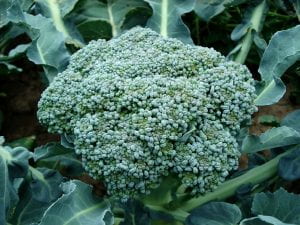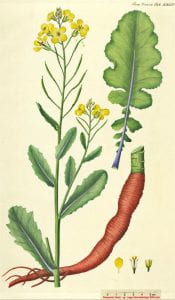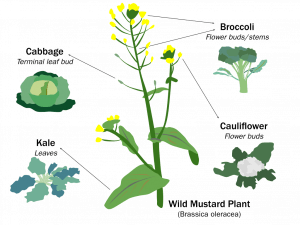by Joan Kean, Pine Bush Master Gardener Volunteer
 Is broccoli man-made? This was a question recently posed to me by a newcomer to the Community Garden that I frequent. I had no idea as to the correct answer, so I told the gentleman that I would have to research the topic and would share the results with him as soon as possible. What follows in this article are the results of my research.
Is broccoli man-made? This was a question recently posed to me by a newcomer to the Community Garden that I frequent. I had no idea as to the correct answer, so I told the gentleman that I would have to research the topic and would share the results with him as soon as possible. What follows in this article are the results of my research.
While there are many edible plants that can be foraged in the wild (i.e. asparagus, berries, onions, etc.), broccoli is not one of them. Broccoli is in fact a human invention. It is not known exactly how many years ago broccoli was created, but it is believed that early varieties of this plant were cultivated in the Mediterranean region during the Roman Empire in the 6th century BCE. After its creation over 2000 years ago, broccoli continued to be improved through artificial selection in parts of what is now Italy. Then in 16th century broccoli was introduced in other parts of Europe which eventually lead to cultivation in those areas. Although broccoli was brought over the United States in the 17th century it was not grown commercially until the 1920s.

Broccoli is a derivative of the Brassica oleracea, also known as wild cabbage or wild mustard. The leaves, stems and flowering heads of wild mustard are edible, but bitter. In an effort to improve its palatability, farmers identified characteristics in some wild mustard plants that they wanted to keep and planted seeds from those plants, gradually emphasizing certain traits. This process is a type of genetic modification known as selective breeding or artificial selection.
Selective breeding is an extensive and lengthy process. Plants with favorable characteristics such as larger or tastier fruits and/or greater yield are propagated. Propagation is not only achieved by seed from the desired plants, but also from asexual propagation from cuttings, grafting, layering, etc. Eventually a plant is produced that has the desired characteristics and when reproduced retains those unique characteristics. This new plant is considered a cultivar and has a genetic makeup that differs from the wild type of the plant.
The obvious disadvantage of selective breeding is that it is a very long and laborious process, requiring many years to obtain the desired results. Yet selective breeding is an important process as it is not only used to improve taste and yield, but also to obtain plants that are more resistant to disease and pests as well as withstand harsh environmental conditions, such as low temperatures, drought, wind, and salinity.
 Many of the vegetables included in the Brassiceae family are not actually different species, just cultivars of wild mustard. Plants with a large terminal bud were bred to produce cabbage. Plants with desirable leaves eventually became kale and collard greens. Brussels sprouts were developed from plants with large lateral buds while those with larger stems became kohlrabi. In the case of broccoli and cauliflower, the flowers were the focus.
Many of the vegetables included in the Brassiceae family are not actually different species, just cultivars of wild mustard. Plants with a large terminal bud were bred to produce cabbage. Plants with desirable leaves eventually became kale and collard greens. Brussels sprouts were developed from plants with large lateral buds while those with larger stems became kohlrabi. In the case of broccoli and cauliflower, the flowers were the focus.
Just as broccoli is man-made, all the fruits and vegetables you see in the grocery store today are all a result of thousands of years of genetic manipulation.



